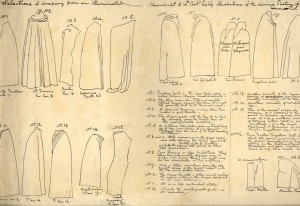Douce counted the artist John Flaxman (1755-1826) among his friends: numerous gifts from the sculptor are recorded in his Collecta and Flaxman’s Compositions from the Tragedies of Aeschylus (1795) was one of the books bequeathed by Douce to the Bodleian.
While going through Douce’s folders of satirical prints, which I will start cataloguing shortly, I came across the etching below:
The folder in question is labelled ‘Burlesques. Satirical and Humorous. English’. Douce owned two impressions of the etching, whose full title is Selections of drapery from an illuminated Manuscript of 14th Cent.y highly illustrative of the divine Poetry of the immortal Dante. In an annotation in pencil, Douce explains that these are ‘Tracings from Flaxman’.
The print is a parody of what Flaxman’s contemporaries praised as his ‘chaste outlines’. The author has a lot of fun suggesting spurious sources for the set of sixteen disembodied cloaks, supposedly copied from Flaxman’s illustrations of Dante. No. 5, for instance, shows ‘A Sublime idea taken from a Towel hung to dry’. Sugar wrappers, a ‘Spanish borachio’ or wine-bag, and a ‘broken Tobacco Stopper’ are other objects from which the artist is said to have drawn inspiration.
As is well known, Flaxman’s 111 illustrations for the Divine Comedy were commissioned by Thomas Hope and produced in Rome between 1792 and 1793. Their circulation was restricted to Hope’s immediate circle of friends until the publication of Tommasso Piroli’s unauthorised second edition in 1802. This anonymous print was probably produced after that date. The satire focuses on the novelty of Flaxman’s style and on his antiquarian interests, which Douce shared and possibly promoted.

